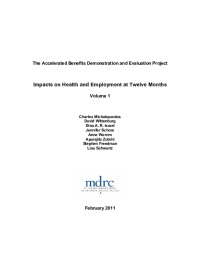The Accelerated Benefits Demonstration and Evaluation Project
Impacts on Health and Employment at Twelve Months
In 2006, the Social Security Administration funded the Accelerated Benefits (AB) Demonstration to test whether early access to health care and related services would improve outcomes for new Social Security Disability Insurance (SSDI) beneficiaries. Under current law, most beneficiaries are not eligible for Medicare for a period of 24 months after they are entitled to receive cash benefits. Many SSDI beneficiaries in this “waiting period” have serious health care needs, and health insurance may provide the medical care needed to stabilize their health conditions.
AB included about 2,000 new SSDI beneficiaries without insurance. Individuals were randomly assigned to one of three research groups: (1) the AB group, which had access to health care benefits designed for the project; (2) the AB Plus group, which had access to the same health care benefits as well as voluntary services delivered by telephone to help them navigate the health care system and return to work; and (3) a control group, which could not receive AB health care benefits or AB Plus services but could obtain health insurance on their own.
Key Findings
- Participants made extensive use of program services. Almost all members of the AB and AB Plus groups used AB health benefits during the first year, most commonly for doctor visits, diagnostic testing, and prescription medications. Program group members averaged $19,265 in AB health benefit claims during the year. In addition, about two-thirds of the AB Plus group participated in key telephonic services.
- AB health care benefits increased health care use and reduced reported unmet medical needs. In addition, members of the AB and AB Plus groups reported spending less of their own money on health care. There were few differences in these outcomes between the AB and AB Plus groups, suggesting that AB’s health care benefits were responsible for these improvements.
- AB Plus services encouraged people to look for work but did not increase employment levels in the first year. Members of the AB Plus group were more likely to use vocational rehabilitation and other job preparation services and were more likely to look for work than either the AB group or the control group. Despite this promising intermediate result, the three groups had similar employment rates in the first year.
These results are promising, but they reflect short-term impacts partway through the intervention. It will be important to continue to track outcomes to assess whether long-term employment gains and reduced need for health care result in future savings for the federal government. Despite these limitations, AB provides perhaps the most rigorous information to date suggesting that health care benefits can improve the health of a medically needy group.






